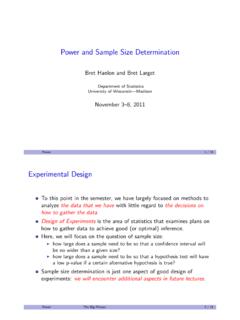Transcription of The Friendly Beginners’ R Course - Department of Statistics
1 1 The Friendly Beginners R Course written by Toby Marthews at the BCI Research Centre, Panama ( ) This Course is only 14 pages long (inc. pictures) and you work through it in your own time so it s probably the least painful introduction to R currently around. Make sure you have the example files that accompany this text ( , , and quadratdata ) otherwise many things won t make sense. Start reading below the line of stars and all should be including how to install R in the first place (if necessary). Toby, August 2005 (last updated April 2010) ** SO . you ve decided you want to learn to use the R language and environment? Well, hmmmmm .. would it perhaps be more accurate to say that either a) your boss/ supervisor/ advisor has told you that you have to and you have a very bad feeling about the whole idea, b) you have some analysis to do and a friend has promised.
2 Against all your common sense . that R is easy to use and can help you, c) you have tried reading Statistics or modelling books, have given up and are desperately hoping that R is a way around them or d) you ve just decided to increase your rating and impress people? Whatever your reasons, I think learning to use R is a good idea . if only to be aware of what a package like this can do. R does a lot of very clever things and can make your life easier if you have to analyse data a lot. The bit is also a good point: since I put it on my CV everyone believes I m much cleverer than I really am. Some comments for those who think R is just another Statistics package: Well, R is both a programming language and a means to do statistical analysis and this is partly why I think it s a step ahead of anything else around at the moment: by learning R you will acquire programming skills (these skills are of what people learn (or should learn) in modelling courses) and the ability to do Statistics on a computer.
3 So, by learning both together, you can gain two sets of skills for the price of one (I wrote this paragraph in 2005 but I noticed in a 2009 article Shock and Awe by Statistical Software . Why R? by Owen Petchey, Andrew Beckerman and Dylan Childs in Bulletin of the British Ecological Society 40 they made similar comments and suggested that R on its own could replace all of Sigmaplot, MS Excel, SAS, Genstat and Mathematica !). DON T BUY AN R TEXTBOOK (at least before you finish these pages): firstly because there is a 2300 page R manual downloadable for free from the R website and secondly because R is not new Statistics but a way of doing standard Statistics more quickly, so you can and should use a STANDARD textbook, just adding notes to it as required.
4 R is similar to (and is a freeware alternative to) MATLAB ( ; for a comparison of the two you can look at ). For users of SAS, SPSS, Stata or Systat, ( ) explains why R can be useful to you too and ~cook/movabletype/archives/2009/01 is a discussion from 2009 about the relative merits of R, SAS, Stata and several other packages. 2 I ve used R only since 2005, which means I really don t know the ins and outs of it, but in the following few pages I should be able to give you a and that should be enough for you to be able to write your own R scripts, use some R functions, draw some nice graphs and generally get familiar with it. This guide is written for someone who s used a computer before but has NO PROGRAMMING EXPERIENCE (if you do have some experience, you ll know which sections to skip below).
5 I can t say how long this text will take to work through (everybody s different), but there are only 6 challenges so hopefully not too long. Set yourself up with a computer, a printout of this text, a strong coffee (or alternative stimulant) and go through the sections starting with .. Installing R & Running an R Program You need a bit of general knowledge of computers and how they work first. If you already know about computer languages and workspace directories and have R installed on your computer then go on to the next section. Computer programs are always written in some kind of computer language. Computer languages are either script ones ( BASIC, JavaScript, R) or compiled ones ( FORTRAN, PASCAL, C, C++, Java) and whichever one a programmer is using, it all has to be translated into machine code (which is a stream of 1s and 0s) before the computer can actually execute or run it (= do it).
6 Here s where the difference lies: with script languages the computer goes through the program and translates and executes each before going on to the next line; with compiled languages the computer translates the whole program in one go, saves the machine code as an executable on disk (in Windows usually with a .exe extension) and then runs the executable directly. Generally speaking, script languages are slow but more user- Friendly (esp. error-reporting) and compiled languages are much faster but are much less straight-forward to use. So, if you write a program in R then it ll run a lot slower than an equivalent program written in C or FORTRAN . and you should be aware of this.
7 But a) the difference will only be noticeable to you if you re doing really lots of calculations, b) if you ve never used a computer language before then you ll be pulling your hair out if you start with something like FORTRAN, c) in the case of R there are all these extra features like and statistical functions that can make your life a lot easier (and FORTRAN, for example, can t do those without special like IDL) and d) if you learn how to program using a language like R then you ll find it really easy to pick up any other computer language afterwards because all languages have similar structures (repeat loops, for loops, if statements, etc.
8 That s all just to set the scene: let s actually do something. Here s how to install R on your computer. I ve done instructions here for WINDOWS and for LINUX (I don t know anything about Apple Macs although R is available for that too) that work at the time of writing for my machine and therefore should work fine for you too. IF USING WINDOWS PLEASE MAKE SURE YOU DO STEPS BELOW EVEN IF YOU HAVE ALREADY INSTALLED R. 3 INSTALLATION FOR WINDOWS: 1. Go to the R website , click on Download/CRAN on the left and choose a mirror site geographically near to you (to reduce download time). Choose Windows and click on base , download the Setup Executable (click on Download R for Windows , where the x s are numbers) and save it on the Desktop (an.)
9 Exe file). on this to run the installation (make sure you tick the options to get all the on-line PDF manuals and accept the default startup options). YES to a Start Menu folder and YES to a desktop icon but NO to a Quick launch icon (see Step 3). R is now on your computer (and you can delete the file on the Desktop). 2. Create a workspace directory on the Desktop (or elsewhere if you prefer) for using R ( on the Desktop background, choose New .> Folder and give it a name) and copy (accompanying this text) into it. This directory is used by R for storing variables and function definitions (in a file called .RData ) so you have to have one (oh, and A.
10 > B is my way of saying go to menu A and select B from it ). WATCH OUT: in a particularly annoying way, some windows systems automatically rename email attachments called as or when you save them and you need to keep renaming them back to . 3. on the desktop shortcut that should have appeared during installation, and choose Properties . Leave the Target as it is, but modify the Start in box so that it has the location of the workspace directory you created in step 2 and click Apply . Next, open the RGui by on the desktop shortcut ( Gui = Graphical User Interface ). By looking at File .> Source R , check that R opens in the right workspace directory (the window that appears should be the directory from step 2: if it is, just cancel without sourcing any files, but if not go back to step 2).















